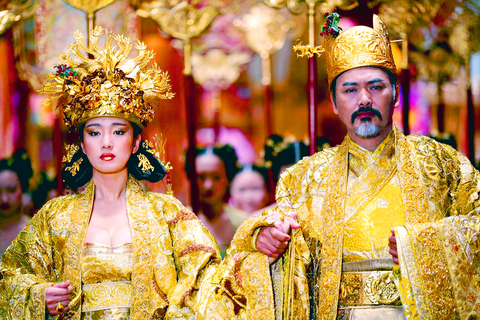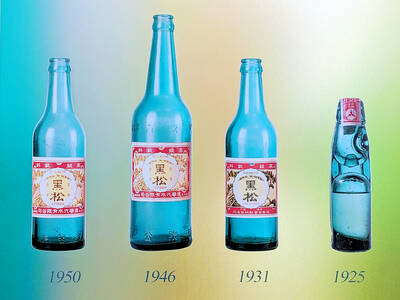Reportedly the biggest-budget Chinese film ever made, Zhang Yimou's (張藝謀) garishly familiar melodrama-cum-martial arts extravaganza Curse of the Golden Flower (滿城盡帶黃金甲) is the ultimate cinematic representation of flamboyance and excess. Led by Chow Yun-fat (周潤發) and Gong Li (鞏俐), the lavish period drama tells of a quasi-Shakespearean familial war in a weighty manner.
The story begins with an Emperor (played by Chow) of a fictional kingdom in 10th-century China during the Tang Dynasty marching home shortly before the Double Ninth festival (重陽節), which is, in part, a celebration of family. The Emperor and Empress' (played by Gong) marriage is overshadowed by homicidal intrigue as she discovers the medicine her husband orders her to take every two hours contains a poisonous fungus that will soon drive her insane.
Distraught with the end of her affair with stepson Crown Prince Xiang (Liu Ye), who is also romantically involved with the imperial doctor's daughter (we later find out the young lovers are in fact half blood siblings), the Empress quietly cooks up a coup with her loyal son Prince Jei (Jay Chou) as the imperial family members follow their paths of destruction in court intrigue, incest, murder and massacre.

PHOTO: COURTESY OF BVI
Based on Chinese dramatist Cao Yu's (曹禺) 1934 play Thunderstorm (雷雨), Curse of the Golden Flower can be seen as a hyper-ostentatious version of the director's 1991 masterpiece Raise the Red Lantern (大紅燈籠高高掛) as both center on the repression of women in patriarchal society. Yet, while a married woman's stifled life is poetically and acutely captured in the former, the latter portrays the human drama with a mannered theatricality.
The opening sequence heralds a promising epic with masterfully executed cross-cut shots between scores of young maids preparing themselves for the Emperor's arrival [representing women] and the pounding footfalls of the army and its entourage [representing men]. The magnificent on-screen presences of Chow and Gong cocooned in opulent gold quickly emerge from the labyrinth of courtyards and halls, mesmerizing the audience with forceful intensity.
But as the film progress, the fatal flaw of a tell-don't-show narrative gradually looms large as we see two of the greatest film stars in the Chinese-speaking world struggle with the confinement of line reading rather than unleashing their talents in subtle physical performances.
Oddly enough, the over-the-top performances do seem to have found a niche in Zhang's grand opera in which love and death are played out at fever pitch in an unparalleled visual pageantry. Visually spectacular, the film creates a novel imperial palace compared to other Chinese period dramas. Swirls of primary colors shine through the glass in pillars, windows and walls, while kaleidoscopic patterns of flowers saturate the immaculate interiors of the palace. The ornate sets and feverish visual design alone are enough to make this film a peculiar work of cinematic art with a kitsch sensibility.
The final epic battle between imperial factions seems to be born out of the desire to equal the high digital standards set by the Lord of the Rings trilogy. In the dehumanized CGI battle sequences, thunderous armies pose in perfect symmetry on millions of bright yellow chrysanthemums covering the imperial courtyard. It is again a stunning visual presentation in abstract form but devoid of human elements.
However, director Zhang manages to exert his artistic instincts in the after-battle sequence when imperial janitors clean up the bloody mess of millions of corpses as if they were merely rolling up a stained carpet.
An entry for this year's Oscars, Curse of Golden Flower is enchanting because of its theatrical indulgence, a peculiar accomplishment to some, but a failure on the part of the seemingly lost Chinese director for others.

Behind a car repair business on a nondescript Thai street are the cherished pets of a rising TikTok animal influencer: two lions and a 200-kilogram lion-tiger hybrid called “Big George.” Lion ownership is legal in Thailand, and Tharnuwarht Plengkemratch is an enthusiastic advocate, posting updates on his feline companions to nearly three million followers. “They’re playful and affectionate, just like dogs or cats,” he said from inside their cage complex at his home in the northern city of Chiang Mai. Thailand’s captive lion population has exploded in recent years, with nearly 500 registered in zoos, breeding farms, petting cafes and homes. Experts warn the

No one saw it coming. Everyone — including the Chinese Nationalist Party (KMT) — expected at least some of the recall campaigns against 24 of its lawmakers and Hsinchu Mayor Ann Kao (高虹安) to succeed. Underground gamblers reportedly expected between five and eight lawmakers to lose their jobs. All of this analysis made sense, but contained a fatal flaw. The record of the recall campaigns, the collapse of the KMT-led recalls, and polling data all pointed to enthusiastic high turnout in support of the recall campaigns, and that those against the recalls were unenthusiastic and far less likely to vote. That

The unexpected collapse of the recall campaigns is being viewed through many lenses, most of them skewed and self-absorbed. The international media unsurprisingly focuses on what they perceive as the message that Taiwanese voters were sending in the failure of the mass recall, especially to China, the US and to friendly Western nations. This made some sense prior to early last month. One of the main arguments used by recall campaigners for recalling Chinese Nationalist Party (KMT) lawmakers was that they were too pro-China, and by extension not to be trusted with defending the nation. Also by extension, that argument could be

Aug. 4 to Aug. 10 When Coca-Cola finally pushed its way into Taiwan’s market in 1968, it allegedly vowed to wipe out its major domestic rival Hey Song within five years. But Hey Song, which began as a manual operation in a family cow shed in 1925, had proven its resilience, surviving numerous setbacks — including the loss of autonomy and nearly all its assets due to the Japanese colonial government’s wartime economic policy. By the 1960s, Hey Song had risen to the top of Taiwan’s beverage industry. This success was driven not only by president Chang Wen-chi’s